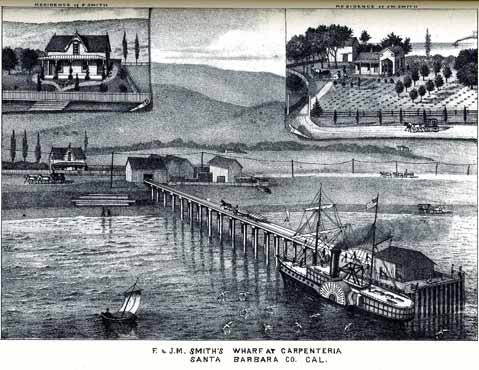What is the history of the Serena Wharf?
Carpinteria's Gateway to the World

Question submitted by Norma Jungjohann
The Serena Wharf is a lesser-known part of the South Coast’s maritime history. The commercial life of the wharf only lasted some 20 years. Yet, for a time, it and Santa Barbara’s Stearns Wharf were the region’s primary shipping links with the outside world.
Serena is the area between Summerland and Carpinteria, about where the polo fields are today. Reportedly, Milton Smith named his property here, La Serena, in the early 1860s for its tranquility. One of his younger brothers, Frank, would figure prominently in the story of the Serena Wharf.
Frank Smith was born in Illinois in 1845. After marrying in 1868, he and his wife, two more of his brothers, and a nephew decided to follow in Milton’s footsteps and headed for California in 1870. At that time, Santa Barbara had one pier, a short one that extended from the end of Chapala Street. Passengers and goods were ferried from the ships to the pier in small boats, because deepwater ships could not tie up at the pier. The system was less than ideal. It was also inconvenient for the settlers of the Carpinteria Valley, who had to wagon their produce to Santa Barbara for shipment and make the same trek to pick up supplies.
In 1871, a group of prominent valley inhabitants, the Trustees of Carpinteria Settlers, bought from the City of Santa Barbara a little more than 11 acres at Serena for $100 to establish a surf landing. Early the following year, the trustees in turn sold the site to Frank Smith and his brother Nelson for the same sum. The brothers used small boats to ferry goods back and forth.
The commercial fortunes of Santa Barbara irrevocably changed with the arrival of John P. Stearns, who completed his deepwater wharf in 1872. Now oceangoing ships could tie up directly to the wharf, which greatly facilitated the loading and unloading of cargo. Freight rates were cut in half. The opening of Stearns Wharf was a watershed event in the city’s history.
The Smiths had been doing a pretty good business until Stearns arrived on the scene. Frank Smith saw the handwriting on the wall and became Stearns wharfinger, or wharf manager, even before Stearns Wharf was completed, while still maintaining his interest in the Serena business. He would later become a part-owner of Stearns Wharf. Rather than see their Serena business totally die, the Smiths built a wharf in 1874, and their proximity to Carpinteria allowed for continued prosperity.
A severe storm in January 1878 destroyed the Serena Wharf. The same storm swept away the Chapala Street pier and severely damaged Stearns Wharf. The Smiths constructed a new wharf, some 800 feet long. They fitted it with wooden rails topped with iron and used small cargo carts to move freight between their warehouses and the ships. Frank Smith bought ever larger shares of the business until becoming sole owner in 1889.
By that time, however, profits were dwindling. The arrival of the railroad, which linked Santa Barbara to Los Angeles in 1887, changed everything. Under the impact of the resulting land speculation, there was a short-lived attempt to establish a town at Serena. One speculator erected a huge sign to attract settlers that read, “Serene, Serener, Serenest.” When the land boom went bust, so did the idea of a town.
The railroad spelled the end of Serena as a shipping site. Frank Smith sold his holdings in the mid 1890s; in 1898 he bought John Stearns’s interest in Stearns Wharf. Smith later served as Santa Barbara mayor and as county assessor. The wharf at Serena slowly deteriorated. By 1910, it was becoming hazardous to public traffic, by the 1940s, only a few broken pilings remained. Today, nothing is left of what once was Carpinteria’s gateway to the world.



